Curiosity health checks good; MRO snaps descent photo
Editor's note...
CBS News
PASADENA, Calif.--The nuclear-powered Curiosity Mars rover survived its nail-biting plunge to a pinpoint landing on the floor of Gale Crater in remarkably good shape, engineers said Monday, setting down on a flat, wind-swept plain littered with uniform gravel-like rocks and firm soil.
In a low-resolution view from a hazard avoidance camera on Curiosity's back fender the rim of Gale Crater can be seen some 12 miles away to the northwest while a fisheye view from a front hazcam shows Mount Sharp, a 3-mile-high mound of layered rocks to the southeast that the rover will attempt to climb later in its two-year mission.
While the grainy, black-and-white hazcam views do not compare to the spectacular color images expected later, scientists and engineers were elated.
"To me, it's representative of a successful landing on Mars, it's representative of a new home for the rover, it's representative of a new Mars that we've never seen before," said mission manager Mike Watkins. "And so every one of those pictures is the most beautiful picture I've ever seen."
Later Monday, engineers expected the rover's high-gain antenna to deploy, allowing direct-to-Earth communications, and on Tuesday, Curiosity's main camera mast will be erected, setting the stage for the start of what will eventually be a flood of high-resolution imagery.
"A day or so from now, we're then going to deploy the remote sensing mast so we can take these beautiful panoramas that we've all been waiting to see," Watkins said. "But as for now, the first order of business is to make sure the communications to the Earth are healthy and that's the prime activity upcoming for today."
Along with the thumbnail hazcam images, the Mars Reconnaissance Orbiter team released a stunning photograph taken from orbit showing Curiosity descending toward the surface under its 70-foot-wide parachute six minutes after atmospheric entry, just before the rover and its rocket-powered sky crane dropped away for the final descent.
MRO was 211 miles from Curiosity as it flew almost directly overhead, but the parachute and the spacecraft's backshell were clearly visible. The spacecraft's heat shield, jettisoned a few moments earlier, also could be seen falling away, a small black dot against the marsscape far below.
Later Monday, a short movie made up of selected thumbnail frames from a camera shooting four frames per second during the rover's descent was released, showing the heat shield falling away and a circular cloud of dust that was kicked up by the descent stage's rocket engines as it neared the surface. A full-resolution movie with the full set of images is expected to be released in a few weeks.
But the near term focus is to thoroughly check out Curiosity's complex systems, scientific instruments, cameras and other equipment to make sure the remotely operated robot geologist is ready for a planned two-year science mission.
Curiosity landed around 3 p.m. local time on Mars and spent the night in electronic hibernation while its nuclear generator recharged the rover's battery. During its first full day on the surface, engineers planned to uplink commands to the rover's low-gain antenna, ordering the robot to deploy its more powerful high-gain antenna to test its ability to track Earth as it moved across the martian sky.
The direct-to-Earth communications link will be used to uplink commands and to downlink data from the spacecraft when NASA satellites are not above the horizon and unable to serve as relay stations.
Watkins said telemetry from the rover relayed to Earth by NASA's Mars Odyssey orbiter showed the spacecraft landed in good condition and successfully transitioned from entry, descent and landing mode to "surface nominal" mode with no major anomalies.
"I think we all believed it would land successfully," he said. "It's a very complex vehicle and we were a little bit concerned we would land in a safe mode or something like that and it would take us a little while to get out of it. We might not get a comm pass ... and so we'd have to sit and worry and just wait.
"The fact that it went straight into surface nominal, didn't safe, we got great telecom performance, the orbiters performed beautifully, this very complicated avionics with redundant computers and redundant avionics modules have all been fine," he said. "I think we're pleasantly surprised with how smooth that part is going."
The goal is to search for carbon compounds that are critical to life as it is known on Earth and to determine whether Mars was ever habitable.
"The surface mission of Curiosity has now begun," Watkins said. "We built this rover not just to be launched or not just to land on Mars, but to actually drive on Mars and execute a very complex and beautiful science mission.
"We have ended one phase of the mission, much to our enjoyment, but another part has just begun. And it's really the fundamental reason we built the rover. We're just starting that mission."
Preliminary data indicates Curiosity set down a bit more than a mile downrange of its target in the center of a 12-mile-long landing target ellipse -- a bullseye compared to earlier landings. The rover is essentially level and hazcam images show the wheels did not sink into the soil, indicating a firm footing.
"You've heard us speaking about the alluvial fan that we think we've landed very close to the end of and this is the source area, so this is bringing materials in from the rim," said Project Scientist John Grotzinger. "In the foreground, you see a scene that's very familiar to you from other images of Mars, what is undoubtedly a windswept plain with coarse fragments left behind."
The landing site is interesting scientifically "because one of the things we're going to want to do after the commissioning period is over is scoop up some of the soil and analyze it," Grotzinger said. "And what we would really like to do is analyze something that we feel is very representative of Mars. ... We then have a sample of what could be the most global sample of Mars we could measure."
- Posted at 03:40 PM EDT, 08/06/12: Curiosity health checks good; MRO snaps descent photo
- Updated at 08:30 PM EDT, 08/06/12: Adding pictures
CBS News
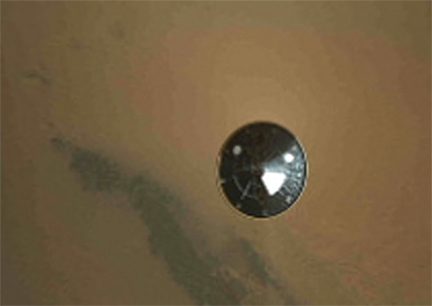 |
| A camera on the Curiosity rover shot video during the spacecraft's descent to Mars, including this thumbnail frame showing the vehicle's heat shield falling away. A full-resolution movie of the descent will be available in the next few weeks. (Credit: NASA) |
In a low-resolution view from a hazard avoidance camera on Curiosity's back fender the rim of Gale Crater can be seen some 12 miles away to the northwest while a fisheye view from a front hazcam shows Mount Sharp, a 3-mile-high mound of layered rocks to the southeast that the rover will attempt to climb later in its two-year mission.
While the grainy, black-and-white hazcam views do not compare to the spectacular color images expected later, scientists and engineers were elated.
"To me, it's representative of a successful landing on Mars, it's representative of a new home for the rover, it's representative of a new Mars that we've never seen before," said mission manager Mike Watkins. "And so every one of those pictures is the most beautiful picture I've ever seen."
Later Monday, engineers expected the rover's high-gain antenna to deploy, allowing direct-to-Earth communications, and on Tuesday, Curiosity's main camera mast will be erected, setting the stage for the start of what will eventually be a flood of high-resolution imagery.
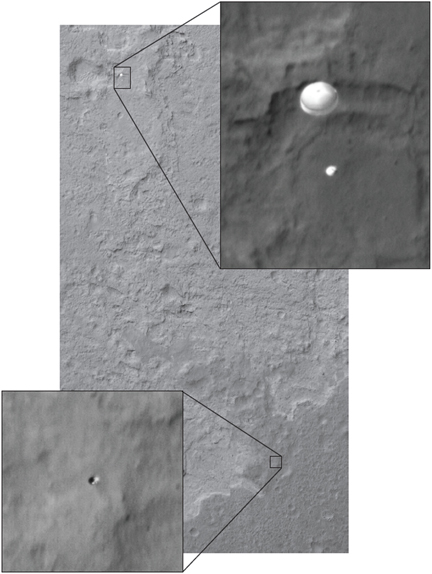 |
| NASA's Mars Reconnaissance Orbiter spacecraft captured this image of the Curiosity rover descending under its 70-foot-wide parachute toward a pinpoint landing in Gale Crater Sunday evening as the orbiter passed 211 miles overhead. The image also shows Curiosity's heat shield falling away. (Credit: NASA) |
"A day or so from now, we're then going to deploy the remote sensing mast so we can take these beautiful panoramas that we've all been waiting to see," Watkins said. "But as for now, the first order of business is to make sure the communications to the Earth are healthy and that's the prime activity upcoming for today."
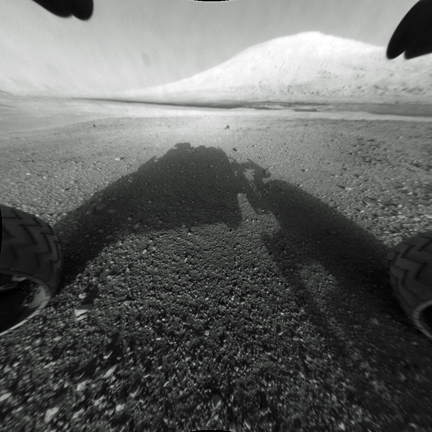 |
| The view from Curiosity's front hazcam, showing Mount Sharp rising three miles above the floor of Gale Crater. (Credit: NASA) |
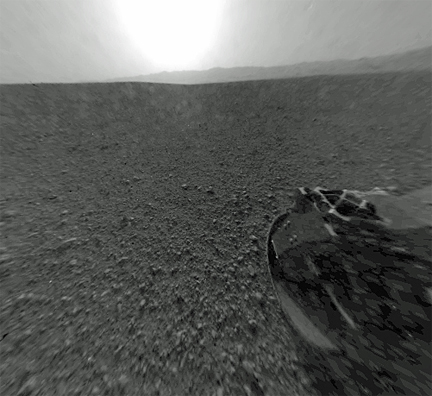 |
| A low-resolution view from Curiosity's rear hazcam, showing the rim of Gale Crater about 12 miles away to the northwest. (Credit: NASA) |
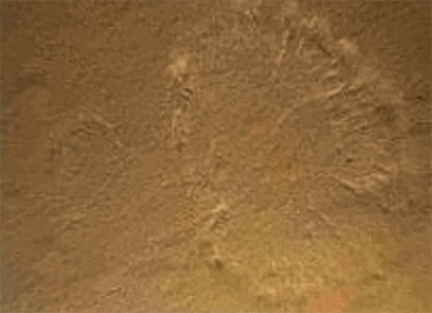 |
| A color thumbnail from Curiosity's descent imager showing the circular cloud of dust kicked up by the rover's sky crane rocket engines as the spacecraft neared the surface of Mars. (Credit: NASA) |
But the near term focus is to thoroughly check out Curiosity's complex systems, scientific instruments, cameras and other equipment to make sure the remotely operated robot geologist is ready for a planned two-year science mission.
Curiosity landed around 3 p.m. local time on Mars and spent the night in electronic hibernation while its nuclear generator recharged the rover's battery. During its first full day on the surface, engineers planned to uplink commands to the rover's low-gain antenna, ordering the robot to deploy its more powerful high-gain antenna to test its ability to track Earth as it moved across the martian sky.
The direct-to-Earth communications link will be used to uplink commands and to downlink data from the spacecraft when NASA satellites are not above the horizon and unable to serve as relay stations.
Watkins said telemetry from the rover relayed to Earth by NASA's Mars Odyssey orbiter showed the spacecraft landed in good condition and successfully transitioned from entry, descent and landing mode to "surface nominal" mode with no major anomalies.
"I think we all believed it would land successfully," he said. "It's a very complex vehicle and we were a little bit concerned we would land in a safe mode or something like that and it would take us a little while to get out of it. We might not get a comm pass ... and so we'd have to sit and worry and just wait.
"The fact that it went straight into surface nominal, didn't safe, we got great telecom performance, the orbiters performed beautifully, this very complicated avionics with redundant computers and redundant avionics modules have all been fine," he said. "I think we're pleasantly surprised with how smooth that part is going."
T
he goal of the $2.5 billion mission is to explore the landing zone, where an alluvial fan visible from orbit indicates the flow of water into the crater in the distant past and the transport of rocky debris. Later, the rover will make its way to the base of Mount Sharp a mile and a half or so away for an attempt to climb up through rock layers that represent a trek through the geologic history of the red planet.The goal is to search for carbon compounds that are critical to life as it is known on Earth and to determine whether Mars was ever habitable.
"The surface mission of Curiosity has now begun," Watkins said. "We built this rover not just to be launched or not just to land on Mars, but to actually drive on Mars and execute a very complex and beautiful science mission.
"We have ended one phase of the mission, much to our enjoyment, but another part has just begun. And it's really the fundamental reason we built the rover. We're just starting that mission."
Preliminary data indicates Curiosity set down a bit more than a mile downrange of its target in the center of a 12-mile-long landing target ellipse -- a bullseye compared to earlier landings. The rover is essentially level and hazcam images show the wheels did not sink into the soil, indicating a firm footing.
"You've heard us speaking about the alluvial fan that we think we've landed very close to the end of and this is the source area, so this is bringing materials in from the rim," said Project Scientist John Grotzinger. "In the foreground, you see a scene that's very familiar to you from other images of Mars, what is undoubtedly a windswept plain with coarse fragments left behind."
The landing site is interesting scientifically "because one of the things we're going to want to do after the commissioning period is over is scoop up some of the soil and analyze it," Grotzinger said. "And what we would really like to do is analyze something that we feel is very representative of Mars. ... We then have a sample of what could be the most global sample of Mars we could measure."